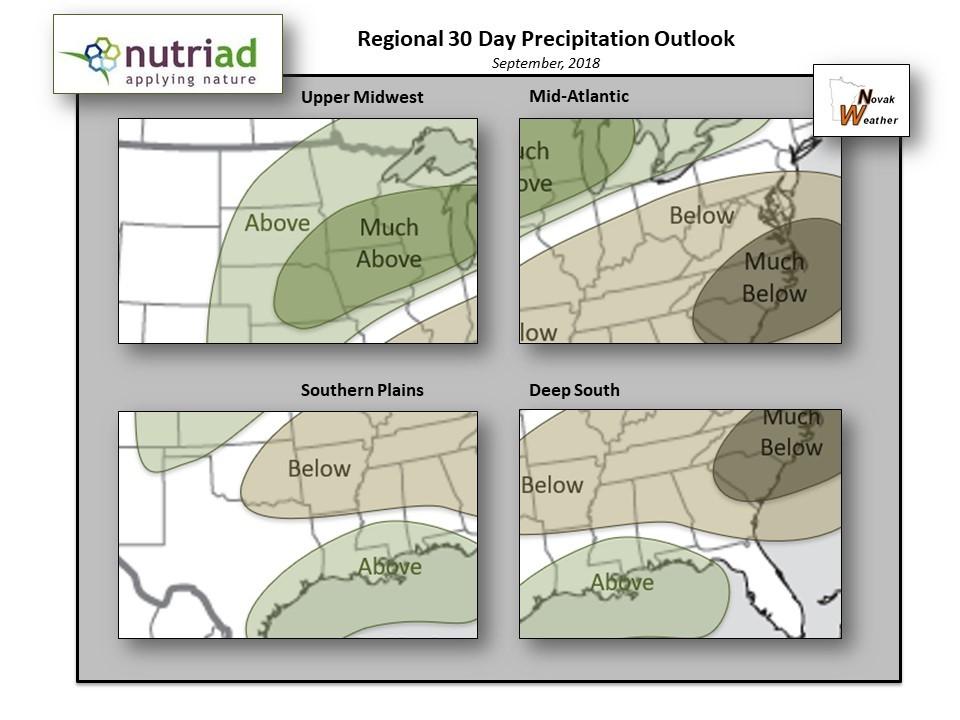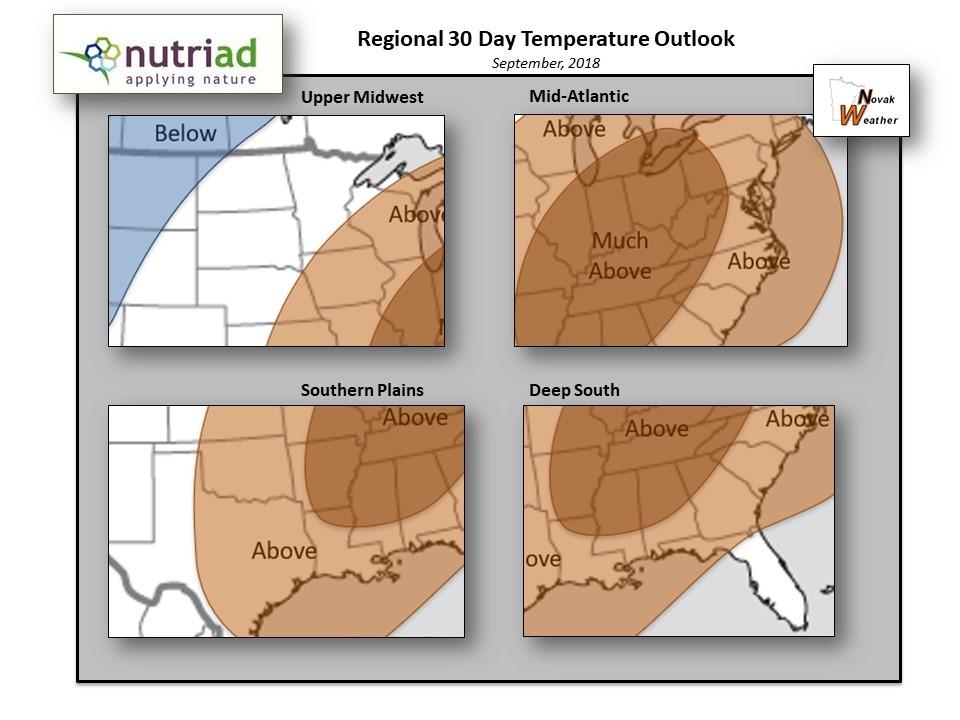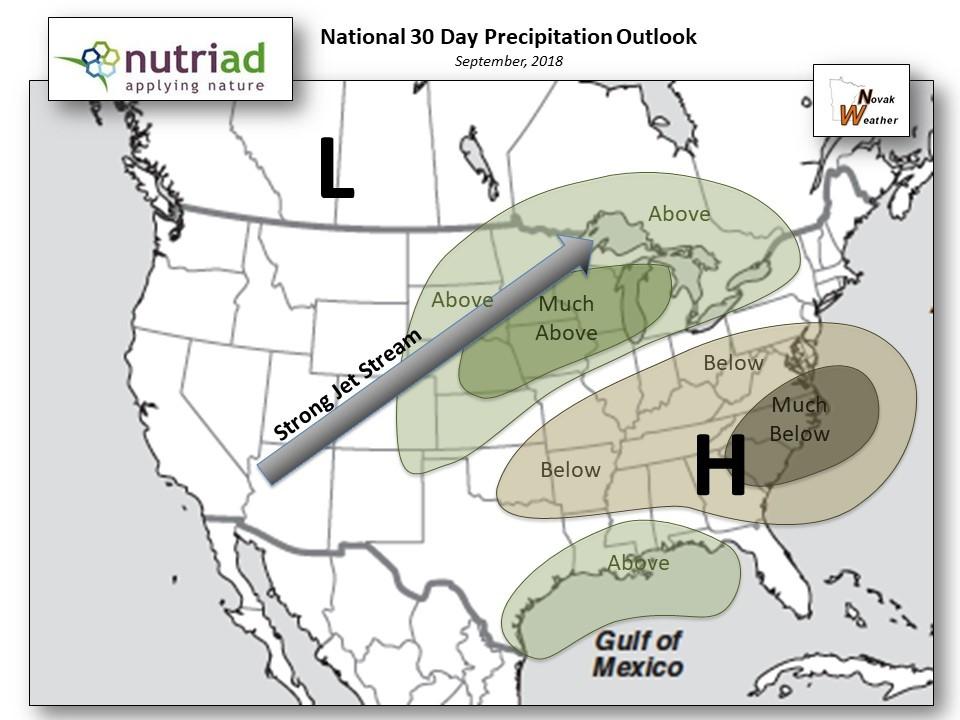September Nutriad Weather and Mycotoxins report.
Published: September 11, 2018
By: Guilherme Bromfman, Director of Business and Product Development at Nutriad
Welcome to the September Nutriad Weather and Mycotoxins report.
As we are approaching the final days of the corn crop 2018 we keep facing weather challenges in most of the production areas across the country.
According to various reports, the crop is in final dough stages, with over 60% already dented. During this stage, farmers are always concerned about two major diseases, the Diplodia and Giberella.
Both these diseases are caused by fungi, which thrive under dry weather conditions prior to silking followed by wet conditions just after it, corresponding to the situation in most of the Midwest in 2018.
Diplodia is caused by a fungus called Stenocarpella maydis. Even not directly related to mycotoxins it can be an important entrance door to other mold contaminations and overall vulnerability of the plant.
In the other side, Giberella is caused by a fungus called Fusarium graminearum, which is directly related to the production of Fumonisins. Studies show that Fumonisin is mainly produced when there is a dry weather during silking followed by wet conditions during dough stages, with its concentration rising between 25 and 40 days after inoculation, coinciding with the dent stage.
Another fungus to be concerned in parts of the US is the Aspergillus, which can produce both Aflatoxins and Cyclopiazonic Acid. This fungus has its optimal growth conditions in hot dry areas, such as the ones seen on the Southern Plains.
As we move to the last crop month prior to harvest it is critical that we follow pretty close the weather conditions and its impact on grain quality and mycotoxins. The Nutriad team is available to support their customers in managing the risks of mycotoxins and will keep sending out reports to better educate the industry.

Picture: Corn damaged by weather conditions in Minnesota, US
NUTRIAD’S United States 30 Day Outlook (September 2018)
Author: Thomas Novak of Novak Weather Consultants
United States Overview
In general, the Jet Stream steering winds will surge onto the northwest coast of the U.S., slice eastward into the Rocky Mountains then continue northeast into the Upper Midwest of the U.S. This jet stream pattern will likely develop a large ridge over much of the eastern U.S. In turn, warmer than normal conditions are expected anywhere east of the Mississippi River Valley (Basically the eastern ½ of the country). Meanwhile, Cooler than average conditions are expected along the northwest coast of the U.S. extending east into the northern Rocky Mountain region.
As the late summer ridge builds over the eastern U.S., DRY conditions will develop under the upper level high pressure system that anchors over the southeastern U.S., and more specifically, the Carolinas. In contrast, a strong jet stream with a Pacific tropical connection will bring plenty of rain to much of the Upper Midwest and Great Lakes regions. Of note, we will be keeping a close eye on the Gulf of Mexico states as the potential exists for a tropical system to develop over the next 30 days. This would bring heavy rains to portions of the Southern Plains and Deep South, especially along the coastlines.
Upper Midwest:
The warm weather pattern will continue, especially over areas near and east of the Mississippi Valley. More importantly, an active jet stream with tropical moisture will be situated overhead much of the month. This will provide the region with plenty of opportunities for heavy rain. In fact, some areas are already experiencing flooding and the expected above average rainfall will only exacerbate an already dangerous flooding scenario in some locations. It has been feast or famine in this region as sharp moisture gradients exist due to spotty summer rains.
Mid-Atlantic:
A strong high pressure ridge with sinking air is expected to anchor near or just south of this region during September. This weather pattern is in sharp contrast to the last several months as a mainly dry and unseasonably warm environment takes hold. Temperatures will often soar 10 to 20+ degrees above average. This will provide the region an opportunity to dry out from the copious summer rains that have fallen, especially over the northern Mid-Atlantic.
Deep South:
The northern sections of this region will experience a dry and warm month as a strong ridge of high pressure anchors nearby. However, all eyes will be on the Gulf and Atlantic Coasts as conditions become favorable for tropical development. If this occurs, heavy rains can be expected, especially along the coasts. Meanwhile, temperatures soar to much above levels as we continue to dry out under sinking air.
Southern Plains:
Special Note: We just can’t seem to shake the intense drought conditions over large sections of the region. Although some much needed rains occurred in pockets during the month of August, it wasn’t enough to alleviate the widespread drought conditions that continue plague this part of the country. Unfortunately, except for tropical rain potential along the Gulf Coast, it appears that much of this region will continue to be starved for moisture.
Concerns continue in this region. The big story all summer as been the prolonged and serious DROUGHT conditions, especially over portions of Kansas, Missouri and Texas. The good news is that the strong high pressure ridge responsible for these drought conditions is expected to anchor east of the region during September. In turn, moisture will have a better opportunity to surge north from the Gulf of Mexico. However, warm southerly winds will dominate which will push temperatures above average for much of the period.





Authors:
Join to be able to comment.
Once you join Engormix, you will be able to participate in all content and forums.
* Required information
Would you like to discuss another topic? Create a new post to engage with experts in the community.
Create a post




